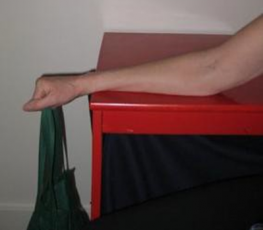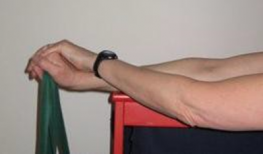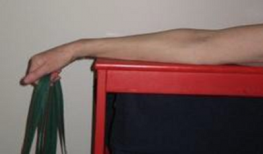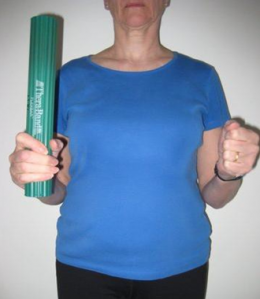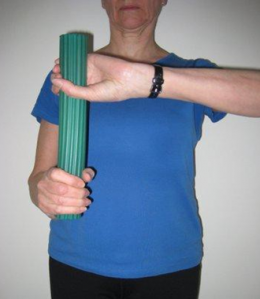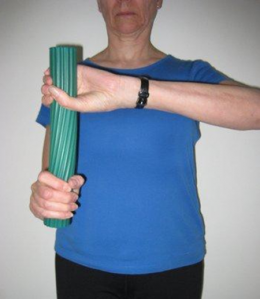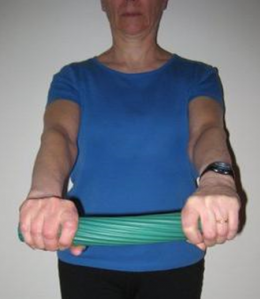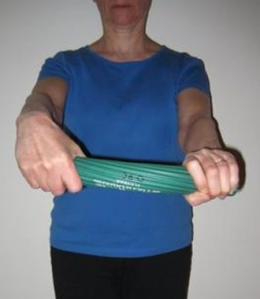Lateral Epicondyle Tendinopathy Toolkit: Section E - Exercise Prescription: Difference between revisions
No edit summary |
Kim Jackson (talk | contribs) No edit summary |
||
| Line 14: | Line 14: | ||
== Introduction == | == Introduction == | ||
Exercises for lateral epicondyle tendinopathy (LET) should be chosen according to patient preference, and the clinical evaluation. | |||
There is a large volume of clinical evidence that consistently supports the use of exercise for management of chronic LET. Studies evaluating strength-based exercise have demonstrated improvement in symptoms regardless of the muscle contraction-type (e.g. concentric, eccentric or isometric). Some evidence suggests that eccentric exercises may provide superior pain relief, but providing an exercise that the patient can tolerate (isometric, concentric or eccentric) is the most important consideration. | |||
The summary of interventions suggests ([[Lateral Epicondyle Tendinopathy Toolkit: Section D - Summary of the Evidence|see section D]]) that clinicians strongly consider using local and upper limb kinetic chain exercises to support patients suffering from chronic LET. The following are examples of exercises to consider based upon the available literature | |||
== Concentric/Eccentric Home Exercise Program == | |||
[Needs a a summary description of concentric/eccentric exercises]. The exercises below are based on a study by Peterson et al 2011<ref>Peterson M, Butler S, Eriksson M, Svardsudd K. A randomized controlled trial of exercise versus wait-list in chronic tennis elbow (lateral epicondylosis). Uppsala Journal of Medical Science. 2011; 116: 269-279.</ref> | |||
{| cellpadding="2" border="1" style="border: 1px solid darkgray;" | {| cellpadding="2" border="1" style="border: 1px solid darkgray;" | ||
|- | |- | ||
| Line 22: | Line 27: | ||
''Protocol:'' | ''Protocol:'' | ||
*Daily, 3-month program. | *Daily, 3-month program. | ||
*Forearm supported in pronation with elbow in some flexion. | *Forearm supported in pronation with elbow in some flexion. | ||
*Resistance 1kg women, 2kg men (1 litre of water = 1kg). | *Resistance 1kg women, 2kg men (1 litre of water = 1kg). | ||
*3 sets of 15 once daily. | *3 sets of 15 once daily. | ||
*Increase resistance by 0.1 kg (100ml water) weekly. | *Increase resistance by 0.1 kg (100ml water) weekly. | ||
*No comment was made regarding pain during exercise. | *No comment was made regarding pain during exercise. | ||
| Line 33: | Line 38: | ||
''Directions:'' | ''Directions:'' | ||
*Lift the weight by extending the wrist, then lower. | *Lift the weight by extending the wrist, then lower. | ||
*The original research used a water container that is unavailable in North America. We have substituted a water bottle in a bag.<br> | *The original research used a water container that is unavailable in North America. We have substituted a water bottle in a bag.<br> | ||
| width="300" | | | width="300" | | ||
[[Image:LET Appendix C Fig1.png|center|264x230px|Fig 1 of LET App C]]''' Figure 1''' | [[Image:LET Appendix C Fig1.png|center|264x230px|Fig 1 of LET App C]]''' Figure 1''' | ||
|} | |} | ||
| Line 43: | Line 48: | ||
<br> | <br> | ||
== Supervised Eccentric Exercise and Stretching Program | == Supervised Eccentric Exercise and Stretching Program == | ||
[Needs a description of eccentric exercises and stretching. The exercises below are based on a study by Stasinopoulos et al 2006<ref>Stasinopoulos D, Stasinopoulos I. (2006) Comparison of effects of cyriax physiotherapy, a supervised exercise programme and polarized polychromatic non-coherent light (bioptron light) for the treatment of lateral epicondylosis. Clinical Rehabilitation. 2006; 20(1): 12-23.</ref> | |||
{| cellpadding="2" border="1" style="border: 1px solid darkgray;" | {| cellpadding="2" border="1" style="border: 1px solid darkgray;" | ||
|- | |- | ||
| width="500" | '' Protocol:'' | | width="500" |'' Protocol:'' | ||
*3 times a week, 4 weeks. | *3 times a week, 4 weeks. | ||
*Forearm supported in pronation with elbow extended. | *Forearm supported in pronation with elbow extended. | ||
*Wrist extended as high as possible then lowered into flexion slowly counting to 30, return to starting position using the other hand. | *Wrist extended as high as possible then lowered into flexion slowly counting to 30, return to starting position using the other hand. | ||
*3 sets of 10, 1 minute rest between sets. | *3 sets of 10, 1 minute rest between sets. | ||
*Resistance, free weights. | *Resistance, free weights. | ||
*Increase resistance when the exercise is pain-free. | *Increase resistance when the exercise is pain-free. | ||
*Exercise with mild pain. Stop if pain becomes disabling. | *Exercise with mild pain. Stop if pain becomes disabling. | ||
*Passive stretching of the extensor carpi radialis brevis tendon (ECRB) done by therapist 3 times before and 3 times after the eccentric exercise. Forearm pronated, elbow extended, wrist flexed and ulnar deviated. Hold 30-45 seconds. 30 second rest between stretches.<br> | *Passive stretching of the extensor carpi radialis brevis tendon (ECRB) done by therapist 3 times before and 3 times after the eccentric exercise. Forearm pronated, elbow extended, wrist flexed and ulnar deviated. Hold 30-45 seconds. 30 second rest between stretches.<br> | ||
<br> '' Directions:'' | <br> '' Directions:'' | ||
*Extend the wrist using the unaffected hand (2A). | *Extend the wrist using the unaffected hand (2A). | ||
*Allow the wrist to flex (eccentric contraction of wrist extensors) (2B). | *Allow the wrist to flex (eccentric contraction of wrist extensors) (2B). | ||
*The original research used hand held weights. We have substituted a bag with weights.<br> | *The original research used hand held weights. We have substituted a bag with weights.<br> | ||
| Line 66: | Line 71: | ||
[[Image:LET Appendix C Fig2a.png|center|264x154px|Fig 2a of LET App C]]''' Figure 2A''' | [[Image:LET Appendix C Fig2a.png|center|264x154px|Fig 2a of LET App C]]''' Figure 2A''' | ||
<br><br> [[Image:LET Appendix C Fig2b.png|center|264x154px|Fig 2b of LET App C]]''' Figure 2B'''<br> | <br><br> [[Image:LET Appendix C Fig2b.png|center|264x154px|Fig 2b of LET App C]]''' Figure 2B'''<br> | ||
|} | |} | ||
| Line 72: | Line 77: | ||
<br> | <br> | ||
== The “Tyler Twist” Eccentric Wrist Extensor Exercise (Tyler et al 2010<ref>Tyler T, Thomas G, Nicholas S, McHugh M. Addition of isolated wrist extensor eccentric exercise to standard treatment for chronic lateral epicondylosis: a prospective randomized trial. Journal Of Shoulder And Elbow Surgery. Sep 2010; 19(6): 917-922.</ref>) | == The “Tyler Twist” Eccentric Wrist Extensor Exercise == | ||
[Needs a description of eccentric wrist externsor exercises]. The exercises below are based on a study (Tyler et al 2010<ref>Tyler T, Thomas G, Nicholas S, McHugh M. Addition of isolated wrist extensor eccentric exercise to standard treatment for chronic lateral epicondylosis: a prospective randomized trial. Journal Of Shoulder And Elbow Surgery. Sep 2010; 19(6): 917-922.</ref>) | |||
{| width="820" cellpadding="2" border="1" style="border: 1px solid darkgray;" | {| width="820" cellpadding="2" border="1" style="border: 1px solid darkgray;" | ||
|- | |- | ||
| Line 113: | Line 118: | ||
|} | |} | ||
== Resources == | == Resources == | ||
Revision as of 13:51, 10 November 2022
Original Editor - Rishika Babburu for BC Physical Therapy Tendinopathy Task Force:
Dr. Joseph Anthony, Paul Blazey, Dr. Allison Ezzat, Dr. Angela Fearon, Diana Hughes, Carol Kennedy, Dr. Alex Scott, Michael Yates and Alison Hoens
Top Contributors - Evan Thomas, Rishika Babburu, Kim Jackson, Admin, Wanda van Niekerk and Vidya Acharya
This article is currently under review and may not be up to date. Please come back soon to see the finished work! (10/11/2022)
Introduction[edit | edit source]
Exercises for lateral epicondyle tendinopathy (LET) should be chosen according to patient preference, and the clinical evaluation.
There is a large volume of clinical evidence that consistently supports the use of exercise for management of chronic LET. Studies evaluating strength-based exercise have demonstrated improvement in symptoms regardless of the muscle contraction-type (e.g. concentric, eccentric or isometric). Some evidence suggests that eccentric exercises may provide superior pain relief, but providing an exercise that the patient can tolerate (isometric, concentric or eccentric) is the most important consideration.
The summary of interventions suggests (see section D) that clinicians strongly consider using local and upper limb kinetic chain exercises to support patients suffering from chronic LET. The following are examples of exercises to consider based upon the available literature
Concentric/Eccentric Home Exercise Program[edit | edit source]
[Needs a a summary description of concentric/eccentric exercises]. The exercises below are based on a study by Peterson et al 2011[1]
|
Protocol:
Directions:
|
Figure 1 |
Supervised Eccentric Exercise and Stretching Program[edit | edit source]
[Needs a description of eccentric exercises and stretching. The exercises below are based on a study by Stasinopoulos et al 2006[2]
Protocol:
|
Figure 2A
Figure 2B |
The “Tyler Twist” Eccentric Wrist Extensor Exercise[edit | edit source]
[Needs a description of eccentric wrist externsor exercises]. The exercises below are based on a study (Tyler et al 2010[3])
|
Protocol:
| ||||||||
Resources[edit | edit source]
- Lateral Epicondyle Tendinopathy Toolkit page
- Section B - Clinical Assessment of LET
- Section C - Outcome Measures
- Section D - Summary of the Evidence
- Section F - Manual Therapy
- Section G - LASER Dosage Calculation
- Section H - Braces, Splints and Taping
- UBC Lateral Epicondyle Tendinopathy (LET) Toolkit
References[edit | edit source]
- ↑ Peterson M, Butler S, Eriksson M, Svardsudd K. A randomized controlled trial of exercise versus wait-list in chronic tennis elbow (lateral epicondylosis). Uppsala Journal of Medical Science. 2011; 116: 269-279.
- ↑ Stasinopoulos D, Stasinopoulos I. (2006) Comparison of effects of cyriax physiotherapy, a supervised exercise programme and polarized polychromatic non-coherent light (bioptron light) for the treatment of lateral epicondylosis. Clinical Rehabilitation. 2006; 20(1): 12-23.
- ↑ Tyler T, Thomas G, Nicholas S, McHugh M. Addition of isolated wrist extensor eccentric exercise to standard treatment for chronic lateral epicondylosis: a prospective randomized trial. Journal Of Shoulder And Elbow Surgery. Sep 2010; 19(6): 917-922.
